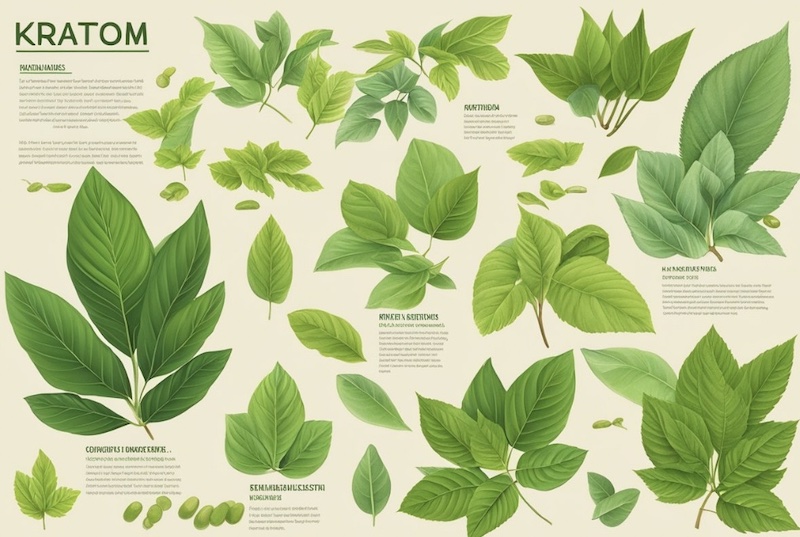Kratom, or Mitragyna speciosa, is a tropical evergreen tree that belongs to the coffee family and is indigenous to Southeast Asia. Its leaves have long held a place in traditional medicine in countries like Thailand, Indonesia, Malaysia, and Papua New Guinea. In these regions, locals have turned to kratom for its ability to relieve pain, enhance mood, and assist in overcoming fatigue. The utility of this plant lies in the alkaloids found within its leaves, which impact the human body and mind in various ways.
The discussion surrounding kratom is multifaceted. On one hand, people praise its natural origins and its historical usage spanning centuries. On the other, the potential for misuse and the side effects associated with its consumption have spurred debates on its legality and safety. The compounds in kratom leaves interact with opioid receptors in the brain, yielding effects that range from mild stimulation to sedation, depending on the dosage and strain of the plant used. This has led to its popularity among those seeking alternative remedies for chronic pain, anxiety, and even as a means to mitigate opioid withdrawal symptoms.
Despite the anecdotal endorsements of kratom by many users, it is crucial to approach its consumption with caution. The effects are still being studied, and regulatory agencies have expressed concerns regarding its safety profile. While some individuals report significant relief from various ailments, others have encountered adverse reactions. Navigating the legal landscape and the scientific research surrounding kratom is as complex as the diverse experiences reported by its users. As the debate continues, understanding kratom’s properties and uses becomes all the more essential for informed decision-making.
Historical Context and Traditional Use
Tracing the roots of Kratom reveals a substantial connection to the culture and traditional medicine of Southeast Asia. Historically, its use has been woven into the daily life and rituals of people across this region.
Origins and Cultural Significance
Native to the lush tropical forests of countries such as Thailand, Malaysia, Indonesia, Bali, and Borneo, Kratom, or Mitragyna speciosa, belongs to the Rubiaceae family. In these societies, the Kratom plant has carried a deep cultural significance. It’s integrated into the farming communities’ social fabric partly because its use implies one is hardworking.
In Thailand, farmers have traditionally chewed Kratom leaves to endure long hours of labor under the scorching sun. Similarly, in Malaysian culture, its consumption during social gatherings and rituals has been common practice. The indigenous communities in these regions have respected and utilized Kratom for its psychoactive properties, offering them both stimulation and relaxation depending on the dosage and the strain of the leaves.
Kratom in Traditional Medicine
Within the realm of traditional medicine, Kratom leaves have historically been harnessed for their medicinal properties. This use is particularly evident in the rural regions of Thailand, Malaysia, and Indonesia, where access to modern healthcare facilities may be limited.
Kratom’s use in traditional medicine has included:
- Pain relief: Villagers often chewed the leaves to alleviate pain.
- Fever reduction: A decoction of the leaves served as an antipyretic.
- Gastrointestinal ailments: Kratom preparations were used to treat various digestive issues.
The cultural and medicinal practices surrounding Kratom deeply reflect the communities’ understanding of the plant as more than just a commodity but as a companion to their way of life and health.
Understanding Kratom
Kratom, derived from the leaves of the Mitragyna speciosa tree, is renowned for its versatile properties which vary across different strains. Each variety offers distinct effects, from pain relief to mood enhancement, attributed to its unique alkaloid composition.
Kratom Varieties and Strains
Kratom is categorized mainly by the color of its veins, which are visible on the leaves, and each carries with it a specific profile of effects:
- Red Vein Kratom: Known for their calming properties, red vein strains are popularly used for relaxation and pain relief.
- White Vein Kratom: These strains are sought after for their energizing effects, often associated with increased alertness and focus.
- Green Vein Kratom: Offering a balance between red and white, green vein strains are used for their well-rounded effects, providing a mild energy boost along with some pain relief.
Common strains include:
- Maeng Da: A potent strain available in red, white, and green varieties, offering a range of effects from stimulation to sedation.
- Bali: Favored for its relaxing qualities and is often used for its potential analgesic properties.
Active Compounds in Kratom
The primary active compounds in kratom are alkaloids, with over 40 identified in its leaves. The two most significant alkaloids are:
- Mitragynine: Predominantly responsible for the stimulant effects in low to moderate doses while providing analgesic effects in higher doses.
- 7-hydroxymitragynine: It has been studied for its potential to relieve pain.
Each strain contains different concentrations of these alkaloids, which contribute to their unique effects on the user. Sites such as Kratom Earth carry different strains in Canada.
Dosage and Consumption Methods
Navigating the complexities of Kratom use can be daunting for newcomers. One must consider the appropriate dosage and the variety of ways it can be ingested, each affecting the body uniquely.
Preparing Kratom Tea
Kratom tea is a traditional method of consumption which involves steeping the kratom leaves or powder in hot water. Users typically measure between 2 and 8 grams of kratom powder, depending on the desired effect, to brew into a tea. To mitigate its bitter taste, honey or sugar can be added. Tea allows for a more gradual onset of effects which can be easier to manage for some individuals.
Capsules, Powders, and Extracts
Kratom is also available in several other forms:
- Capsules: Pre-measured, convenient, and discrete, they negate the need for tasting the powder directly.
- Powders: Versatile for mixing with food or drinks, they offer variable dosing starting at 2-4 grams.
- Extracts: Concentrated forms of kratom, they are typically stronger, meaning consumers should be mindful of the lower doses required.
People beginning with kratom might start to feel effects after consuming 2 to 3 grams on an empty stomach and can adjust their dose after about 30 to 45 minutes, based on personal tolerance and response.
Guidelines for Consumption
Consuming kratom should be done responsibly, and starting with a low dose is key. Users may increase their dose gradually while observing their body’s response. Here’s a simple dosage guideline to consider:
- Microdose: Less than 2 grams
- Low dose: 2-6 grams
- High dose: Over 6 grams
- Heavy dose: Higher than 8 grams
To manage their intake throughout the day, users may take their optimal dose every 5-6 hours. It is vital for one to listen to their body and adjust accordingly, never exceeding the heavy dose range to prevent adverse effects.
Effects and Potential Benefits
Exploring the diverse range of effects that kratom has to offer, it becomes evident that its uses range from stimulating properties to sedative effects, all the way to its potential medical applications for pain management.
Kratom as a Stimulant
When consumed in lower doses, kratom acts as a stimulant. Individuals often report increased energy and motivation, which translates to a heightened sense of well-being and reduced fatigue. The stimulant effects are because kratom interacts with opioid receptors in the brain, leading to an uplift in mood and vitality.
- Energy boost: Users experience a surge in energy levels.
- Mood elevation: There is a noticeable improvement in the overall mood.
Sedative and Relaxing Effects
Conversely, higher doses of kratom are known to produce sedative effects. These relaxing properties make it a substance that some consider for dealing with anxiety or stress.
- Sedative: Kratom can help calm the nerves and promote relaxation.
- Stress relief: Potential to alleviate feelings of stress and anxiety.
Pain Management and Other Medical Uses
Kratom is also utilized for its analgesic properties, particularly among those suffering from chronic pain. The interaction of kratom with opioid receptors can lead to significant pain relief, which has made it a subject of interest for medical use.
- Chronic Pain: Potential alternative for managing long-lasting pain.
- Medical Use: Investigated for its application in various medical conditions.
Legality, Safety, and Regulatory Issues
Navigating the complex landscape of kratom’s legality and safety requires understanding the varied perspectives of regulatory agencies and the legal status in different regions. Consumers, healthcare providers, and vendors must be informed of the current framework governing kratom’s use and distribution.
Legal Status Around the World
Kratom’s legal status varies significantly from country to country and, in the United States, from state to state. In the U.S., states like Alabama, Indiana, Rhode Island, Vermont, Wisconsin, and Arkansas have outright banned the substance. They consider it illegal to buy or sell kratom within their jurisdictions due to concerns about its potential for abuse and safety.
- Alabama: Banned
- Indiana: Banned
- Rhode Island: Banned
- Vermont: Banned
- Wisconsin: Banned
- Arkansas: Banned
Internationally, the legality of kratom also varies, with some countries imposing severe penalties for its possession and use.
FDA Perspective and Safety Concerns
The U.S. Food and Drug Administration (FDA) has not approved kratom for any medical use. The FDA has expressed concerns regarding its safety, citing risks such as addiction, abuse, and potential serious health implications. They highlight cases of kratom associated with psychiatric, cardiovascular, gastrointestinal, and respiratory problems. Even more foreboding are the rare but serious incidents and fatalities where kratom use was a contributing factor, often in combination with other substances.
Despite the FDA’s stance, an estimated 1.7 million Americans have used kratom, often pursuing it to self-treat conditions like pain, anxiety, depression, or to mitigate opioid withdrawal symptoms. This underscores the tension between potential therapeutic applications and regulatory apprehension about its safety profile.
Side Effects and Risks
When exploring the world of Kratom, it is crucial for individuals to be aware of the possible side effects and risks associated with its use. Kratom, while beneficial for some, carries the potential for adverse reactions and dependency.
Common Adverse Reactions
Experiencing side effects from Kratom use is not uncommon. Users often report nausea and constipation as frequent issues. Here is a list of some common adverse reactions people may encounter:
- Nausea
- Constipation
- Drowsiness
- Loss of appetite
- Aggression
- Respiratory depression
- Seizures
These side effects may intensify with higher dosages of Kratom.
Managing Dependence and Withdrawal
Regular Kratom users might develop dependence, which can lead to challenging withdrawal symptoms. Withdrawal can manifest as:
- Muscle aches
- Insomnia
- Irritability
- Emotional changes
- Aggressive behaviors
An effective way to manage these concerns is by gradually reducing the amount of Kratom used, thus mitigating withdrawal intensity. Consulting healthcare professionals is also advisable when dealing with dependence.
Potential for Misuse and Abuse
Kratom’s ability to impact the brain’s reward system can lead to addiction. Risk factors increase when users consume Kratom with other substances or have a prior medical condition related to substance abuse. Recognizing the signs of misuse, such as seeking Kratom compulsively and neglecting responsibilities, is vital. Prevention and treatment of Kratom abuse include therapy, support groups, and medical care for severe cases such as psychosis or when there’s a life-threatening risk of respiratory depression.
In conclusion, while Kratom may offer some therapeutic effects, its side effects and risks, including potential for abuse, should not be taken lightly. Those considering Kratom usage must weigh these against its possible benefits and proceed with caution.
Kratom in Modern Society
As a natural product with traditional medicinal usage, Kratom has found its place within modern society amidst both controversy and advocacy. It’s a leafy member of the coffee family, gaining attention for its potential benefits and risks. Companies like Kratom Earth sell it not for human consumption.
Community and Advocacy
Within Western society, a growing community of Kratom users and advocates has emerged. They share a common interest in the plant’s potential as a therapeutic substance. These individuals often relate stories of personal triumphs with Kratom, dealing with issues such as chronic pain or the struggle to overcome opioid dependency. Activism plays a critical part here, with groups forming to educate the public and policy-makers about Kratom’s uses. They underscore Kratom’s status as a natural product that should be available to those who seek its traditional medicinal benefits. Some companies in Canada offer it online such as Kratom Earth.
- Key Points:
- Personal stories as a drive for advocacy.
- Education and lobbying for legal acceptance.
Integration into Western Wellness Practices
Kratom’s integration into Western wellness practices is multifaceted. As a botanical with a rich history in Southeast Asia, it has crossed oceans to be used in a variety of forms—powdered, encapsulated, or brewed into teas. This integration is sometimes met with skepticism by the medical community, yet those who have experienced positive outcomes often become staunch defenders of its place in holistic health. Wellness practitioners who incorporate Kratom into their practices do so by focusing on its potential to offer relief where traditional methods have not, thereby appealing to those seeking alternatives.
- How Kratom is Used:
- Teas: Brewed for those who prefer natural remedies.
- Capsules: Chosen for measured, convenient consumption.
- Topicals: Used by some for localized issues.
Incorporating Kratom into modern uses bridges a gap between past and present, challenging the status quo and introducing a traditional botanical into the complex ecosystem of Western health and wellness.
Purchasing and Product Quality
When buying Kratom, individuals face the dual challenge of identifying dependable sellers and verifying the purity of Kratom products. These steps ensure not just personal comfort but also the productivity that users seek through its use.
Identifying Reliable Vendors
Seeking out reputable vendors is crucial for any Kratom buyer. Reliable vendors typically provide:
- Transparency: Full disclosure of product sourcing and lab testing results.
- Reputation: Positive reviews and testimonials from other consumers.
- Compliance: Adherence to Good Manufacturing Practices (GMP).
To ensure the quality and safety of Kratom, it is recommended to verify the vendor’s certification with the American Kratom Association (AKA), which establishes standards for Kratom production and sale.
Assessing Kratom Product Purity
The purity of Kratom products is a determining factor in their effectiveness for achieving desired levels of concentration and comfort when used as an alternative to traditional medications. Consumers should look for:
- Lab Testing: Products have been tested for contaminants and alkaloid content.
- Packaging: Proper packaging that protects against contamination and degradation.
- Labeling: Clear and accurate labels displaying strain, vein color, and dosage recommendations.
A purchaser’s ability to discern the quality of Kratom can be enhanced by educating themselves on the distinct properties of different strains and vein colors, which affect the product’s effects.
Personal Experiences and Anecdotes
In exploring the personal impact of Kratom, it’s essential to understand how individual stories paint a broad spectrum of experiences, ranging from relief and well-being to discomfort and cautionary tales.
First-Hand Accounts
Users often turn to Kratom seeking relief from various ailments, with some experiencing significant benefits. John, a 35-year-old software developer, began using Kratom to manage his afternoon fatigue. He reports that small doses of green vein Kratom have become his tool of choice for staying alert and maintaining a positive mood during long workdays. Conversely, Emma, a freelancer battling anxiety and occasional insomnia, found that red vein Kratom helped her relax and achieve a more regular sleep pattern.
Not all experiences are positive, though, and some include side effects. For instance, Daniel experienced dizziness and itching after trying Kratom for his chronic back pain, leading him to discontinue use. Similarly, Sophia, who sought comfort for her depression symptoms, ended up feeling nauseous and vomiting after her first few doses.
Shared Journeys of Discovery
Groups and communities have formed where individuals share their journeys with Kratom, highlighting its varying effects. In forums, users like Mia and Carlos discuss the trial and error in finding the right strains for their specific needs; Mia for her social anxiety, and Carlos for his search for mental clarity and relief from the mental fog of depression.
Many in these communities have swapped stories of how they’ve swapped traditional sedatives for Kratom to find a delicate balance that aids their well-being. They often emphasize, however, that what works for one may not work for another, and they urge new users to proceed with caution to avoid experiences like lightheadedness or exacerbated insomnia.
Kratom and the Future
Kratom stands on the threshold of scientific exploration and public policy discourse, with its future hinging on new research findings and the evolving legal landscape.
Research and Medical Discoveries
Safety and Efficacy: Research into kratom’s potential benefits and safety profile is progressing. Current studies are examining its analgesic properties and how it might be leveraged to relieve pain without the risks associated with traditional opioids. Scientists are keen to understand the alkaloids present in kratom and how they interact with opioid receptors, hoping these discoveries could lead to new, safer medications.
Opioid Dependency: Ongoing research seeks to uncover kratom’s viability as a harm reduction agent for those suffering from opioid dependency. With a minority of kratom users developing a dependency on the plant, the focus is on objective assessment, guided by questions such as: Can kratom offer a safer alternative to conventional opioids? and What are the long-term implications of its use in opioid withdrawal?
Legislative and Community Outlook
Legal Status: The legality of kratom is a mosaic of state and international regulations. In some regions, it remains legal and is used as a dietary supplement. Elsewhere, kratom encounters strict control, with arguments revolving around its effects and potential for dependency. The community’s future role involves advocating for informed legislation that reflects nuanced, evidence-based medical research.
Community Engagement: Advocates within the kratom community stress the importance of unbiased information and responsible use. They often engage in dialogue to better understand kratom’s impact on public health. The community’s perspective underscores the need for balance: embracing potential benefits while being vigilant about safety and long-term health impacts.
Their shared goal is clear: to safeguard the right to make informed decisions about their well-being while promoting scientific inquiry and sensible policy making.
Conclusion
Kratom, a natural herb from the coffee family, has been a subject of interest due to its varied uses, particularly in Southeast Asia. It offers a range of effects, from stimulant properties at low doses to sedative effects at higher doses. Mitragyna speciosa, its scientific name, is cultivated in regions like Indonesia, Malaysia, and Thailand.
The leaves of Kratom can be prepared in several ways:
- Decoction: A traditional tea-like preparation.
- Powder: For mixing with beverages or food.
- Smoking or Vaporizing: Less common methods of use.
People may turn to Kratom for its potential to alleviate pain, fatigue, depression, and anxiety. However, they should acknowledge that research on Kratom is ongoing, and its complete safety profile and potential side effects are not fully understood.
Kratom’s impact on opioid withdrawal and its use as a replacement therapy in opioid use disorder are noteworthy. Its analgesic properties have made it a subject of research and discussion among healthcare providers.
Users should note that while Kratom has traditional and potential therapeutic uses, regulatory agencies like the FDA have not approved it for medical use. Caution is advised, and consultation with a healthcare professional is recommended before use.
Finally, Kratom is a complex substance that may offer benefits but also poses risks. Balanced, well-informed decisions should be made regarding its use.





























